Is your pool green and cloudy? Here’s how to clean it up and keep it swim-ready
Let’s face it. Life gets crazy, and sometimes we let certain cleaning chores slide. Pools need daily care, but they often get neglected when there are other pressing matters at hand. Unfortunately, the longer a pool is ignored, the dirtier it gets until your science teacher’s favorite green microorganism moves in.
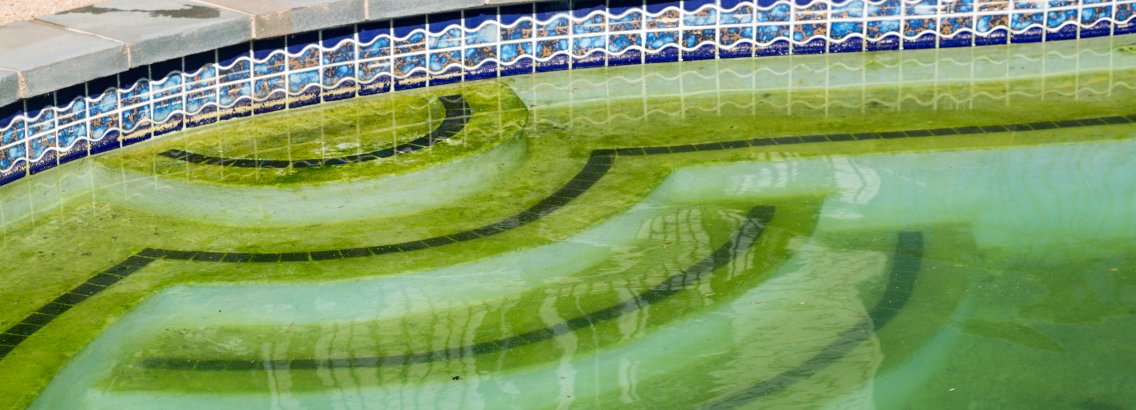
How algae grows

It doesn’t take long for algae to take off and “bloom.” Depending on temperature, contaminants, sunlight, and circulation, algae can bloom in a matter of hours, days or weeks. At temperatures below 51 degrees F, it won’t grow, so it’s safe to cover the pool and let it hibernate until the thermometer rises in spring.
Algae doesn’t need much to thrive. There are many different types of these tiny critters that are loosely lumped into the plant kingdom. Their green color comes from chlorophyll, which is used for photosynthesis. If you remember from your science classes, photosynthesis occurs when carbon dioxide is taken in and oxygen is expelled.
All algae needs is some sun and food, and it can easily thrive in almost any still body of water. Pools have an abundance of food for algae, especially those with lots of debris and dissolved solids. They even feast on chlorine, which is why they can take over when chlorine levels aren’t maintained.
What’s so bad about algae?

While not toxic to swimmers in and of itself, algae can cause other problems such as hosting bad bacteria like E-coli. They can also reduce visibility for divers who are attempting to rescue a person or pet. It can clog up pores in pool filters which can render them useless. It can eat into pool surfaces and stain them.
Since they’re microscopic, they can easily hide out in crevices, behind pool ladders, under pool liners, etc. So basically, you have to be vigilant to prevent it in the first place. An ounce of prevention is worth 15 thousand gallons in the case of keeping algae out of pools.
Six steps to wiping out algae

Depending on the level of algae bloom and filth, there are six basic steps involved in cleaning a green pool. We’ll get into more detail below.
- Debris removal
- Test pH balance & CYA
- Shock the pool with chlorine
- Brush, pump & filter the pool
- Test chlorine levels
- Continued maintenance
Step #1: Remove the debris
If you can’t see at least 6-8 inches below the water’s surface, call a professional. The pool will need to be drained and acid-washed. If you can see 6-8 inches below the surface, roll up your sleeves and get busy.
First you need to remove as much debris as you possibly can. This will take away the algae’s food source and help the chlorine work better. You’ll need a telescopic pole. Start by skimming the surface with a skimmer net on the telescopic pole.
We select, test, review and suggest the best products. We may earn a commission, if you buy something through our links.
Switch the skimmer to a deep pool net and remove all the big debris from the pool’s bottom. It may be hard to see it if the water’s very cloudy, but keep at it until you don’t see any substantial debris in the net.
Read our pool cleaner reviews to find all the cleaning tools you’ll need.Step #2: Test the pH, CYA & free chlorine
You can use a fancy test kit or cheap test strips. Your ideal pH is 7.2 or below. If it’s too high, you’ll need to add muriatic acid (a gallon at a time) or a prepared pH decreaser. Getting the pH low enough will minimize water cloudiness after the next step.
You should also test for CYA (cyanuric acid). You can get special test kits for this. CYA is like sunscreen for your chlorine. If it’s lower than 30 ppm, the sun will break down the Free Chlorine needed to keep algae at bay. To calculate how much CYA you need, use this handy PoolMath Calculator, which also helps calculate other measurements like pH, salt, etc.
If CYA is too high, you’ll have to remove pool water and replace with fresh. Use the PoolMath Calculator to determine how much water you’ll need to remove/replace. Now test for free chlorine with an FAS DPD test kit. Use this CYA – Chlorine Chart to determine how much free chlorine you need to reach shock level.
Step #3: Shock the pool
No, this doesn’t involve electricity. Basically, it’s adding a bunch of chlorine, but you don’t just pour a bottle in and walk away. After your pH is adjusted to 7.2 or below, get a 25 pound bucket of granular chlorine. It may seem like a lot, but it’ll save money buying it like that in bulk since you’ll need chlorine on hand for regular adjustments.
When you determine how much chlorine you’ll need, toss the proper amount of granules out evenly over the water, kind of like you’re feeding corn to chickens. Note: Don’t feed chlorine granules to chickens. You can also use liquid chlorine. Walk around the pool’s perimeter to toss or pour it in so you get chlorine in each area. Let the pool filter pump run to distribute the chlorine throughout the water.
Test the free chlorine again after an hour, and if it’s at or above shock level, that’s good. Keep testing every few hours, at least twice a day, adding more chlorine when needed with the pump running, until the water is crystal clear. This could take a few days depending on the severity of algal growth.
Step #4: Brush, pump and filter the pool
About 24 hours after adding chlorine, you’ll see a drastic difference. Your pool will most likely not be green anymore, but will probably still be cloudy due to all the dead algae. Keep the pump running. Brush the walls, ladders, and steps to dislodge any stuck algae so it can be filtered out.
To remove dead algae that sink to the bottom of your pool, use a manual pool vacuum or run a robotic pool vacuum until the water is crystal clear. Clean your pool filter and vacuum filter bags a few times a day during the shock process.
Step #5: Test for overnight chlorine loss
After the water is clear and you’ve thoroughly brushed and vacuumed the pool, perform an overnight chlorine loss test (OCLT) to see if there are any algae left. Sun and algae will both deplete your chlorine. So test the free chlorine after sundown and the next morning before the sun comes up.
If you detect a loss in free chlorine, then you’ll know there are still algae, so keep the pool at shock level for chlorine the next day. Repeat the OCLT the next night and before sunup the next day. When your free chlorine level remains the same or has only dropped less than 1 point, then you can let the chlorine return to target level.
Step #6: Ongoing maintenance
Now that you’ve rid the pool of its tiny green invaders, keep it that way! Make sure you test your pool water consistently, preferably once a day, but at least once per week. Stock up on all the pool chemicals you’ll need to make adjustments when needed. Keep your free chlorine, CYA and pH in acceptable ranges. Invest in a good chlorinating system (either a floater, in-line or salt system) to keep an adequate level of chlorine in the pool at all times. Brush and vacuum the pool at least once a week. Clean your pool filter regularly and upgrade if needed.
Consider buying an automatic pool cleaner to make things more convenient. We have several top-rated models listed here so check them out to see which one would be best for your pool.
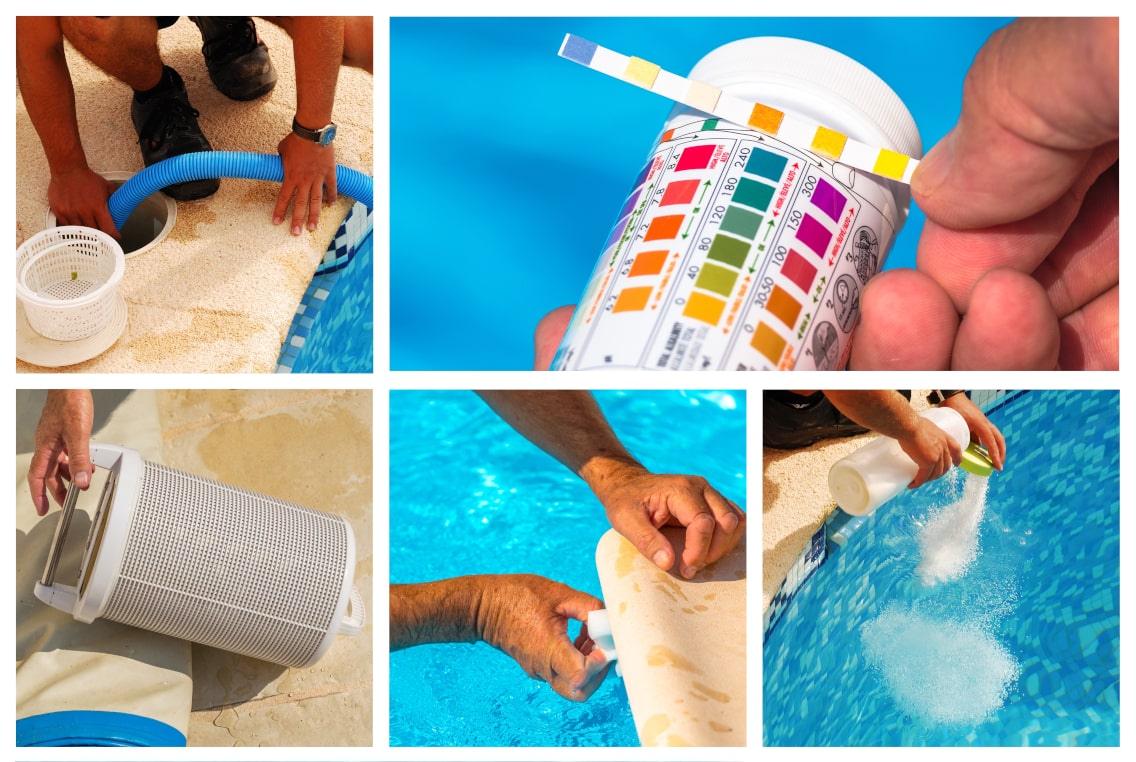
Pool Maintenance Tips & Tricks
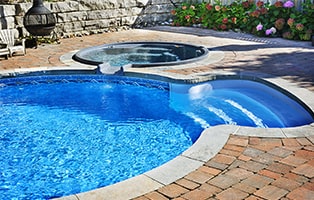

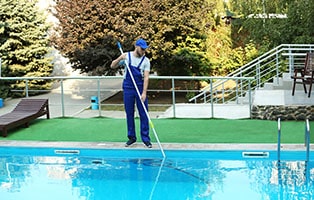



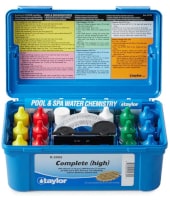
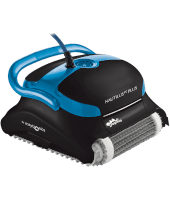
For all those who believe that humans should evolve… don’t believe everything you read. Throwing a ton of chlorine in a pool all the time is very toxic. There are better ways to adjust pH. They just don’t tell you that because pool companies like the money they make on harsh chemicals. Why would we swim in pools filled with toxic chemicals? Because we always did that isn’t a smart answer. Hydrogen Peroxide H202 and sunlight alone make a hydroxyl radical that kills everything and makes your pool a spring. Yes it can also grow algae if you don’t keep up with it and clean it. Barley extract helps with that. Help me spread the word on this. I’m so tired of money winning over logic. The bleach era has to end. Too many people are dying of cancer and COPD. This is why.
So chlorine in pools is the reason so many people get cancer, Interesting! Do you have any evidence of this? What about the thousands that get cancer that never swim in these toxic pools?
Science proves pool chlorine and Clorox type products are very safe . Pool chlorine is a disinfectant and kills bacteria. Barley does not. Barley also doesn’t kill algae. Chlorine does.
Have you personally used the barley extract? I’m using hydrogen peroxide currently as I’m allergic to chlorine, but I’m battling algae. Any recommendations you have are greatly appreciated!
Use a majic eraser for that but after you have cleaned it you need to rinse the spot that you cleaned with water so it doesnt leave a ring of white around the pool.
i agree with Kevin, I have an above ground pool and this has happened 2 times to me. I used the net as much as i could to get out the leaves and also have drained the pool as much as possible and also used a shop vac to suck out the leaves, alge, sticks, etc. (this saved on the wear and tear of my pool pump. ) This definitely works much better. Also then you don’t have to use so much chemicals. Once i got out as much as possible, i wiped down all the walls and started to refill the pool. Once the pool was filled i used the pool vacuum and back washed it to get anything left at the bottom of the pool. Once that was done and started looking good then i start adding my chemicals and test to make sure everything was right levels.
The problem i have now is the stains on my pool liner that are not coming clean. This is a new liner i had installed 2 years ago and i would like it to look new again. Any help with removing the stains?
Ok my pool has been green since day one the people put up my pool then closed it foe winter we’ve yet to swim in pool when they opened it the following summer my water was green they haven’t been able to get pool right yet I used net and there are leaves at the bottom every morning I fish out leaves from bottom I’m sick of this I feel this is the pool people problem since they closed this pool we’ve never swam in pool not once I need help desperately what do I need to do they come every other day with shock and it still green please help me
It keeps turning green because you must get the dead algea out or it starts to grow again . I had this problem year 2 of owning my pool. Shock the pool until it’s clear. If you can’t see the bottom because of green once you shock it, it will most likely turn cloudy. Floating dead algea can look cloudy. I used a product called Fallout the day after I shocked it. This product makes all the dead algea fall to the bottom. Then vacuum on the waste setting. I then invested in an automatic chlorinator called Aqua Smart Plus. As long as I change the cartridges per instructions I don’t have much maintenance at all. I vacuum weekly (more often if we don’t swim much during a week), add liquid chlorine if we get a good rain and keep my skimmer basket empty. Good luck!
Opening pool , my cover was ripped and total loss right at winter time .leaves in pool can’t see the bottom, put shock in,but not sure what to turn pump , just filter . New too this. Any help would be great?
Yes, keep on “filter” until clear. Keep backwashing and rinsing your filter every few hours. First filter, second backwash, third rinse, and forth back to filter. Getting the leaves out is important. Best of luck!
Hey Rob! Before you turn your pump and filter on, you’re going to need to physically remove as many leaves as you possibly can. To do that, use a leaf rake. A leaf rake is a type of skimmer specially designed to collect leaves. They have extra-wide openings, and beveled edges to make it easier to push along your pool’s bottom. Even pools filled with a deep layer of fallen foliage can be cleaned relatively quickly using this tool.
To begin, hold the telescopic handle and dip the net out over the edge and onto the bottom. Slowly move the beveled edge across the pool floor. The pool water at the bottom might be so cloudy you won’t be able to see what you’re doing. That’s okay—the raking action will still pick up the leaves even if you can’t see them. When the rake reaches as far as it can go, turn it over by twisting the handle.
Then, come straight back towards you until the net meets the pool wall.
Grasp the pole hand over hand to reel it in. Don’t lever it straight up, or you’re likely to snap it in half. Put the rake back in the water and repeat until you’ve cleared away all the leaves. Come back in a couple of days when all the suspended particles of dirt settle to the bottom.
Then, use a pool cleaner to clear up the water before turning on your pool’s pump and filtration system. There are several different types, including handheld pool vacuums, suction or pressure types, and robotic pool cleaners.
A self-contained pool cleaner will take the stress off the primary system and make it last longer. Some cleaners are so efficient at what they do, you might not even need a leaf rake!
Very helpful. Thanks
Very helpful just purchased home with pool information explained well feel I can do the job with less help from a professional
I was gone for a 2 weeks came home to a disaster in my pool it was green and when I scaped the bottom of the pool it was black so in drained it and still can’t get it off what do I do